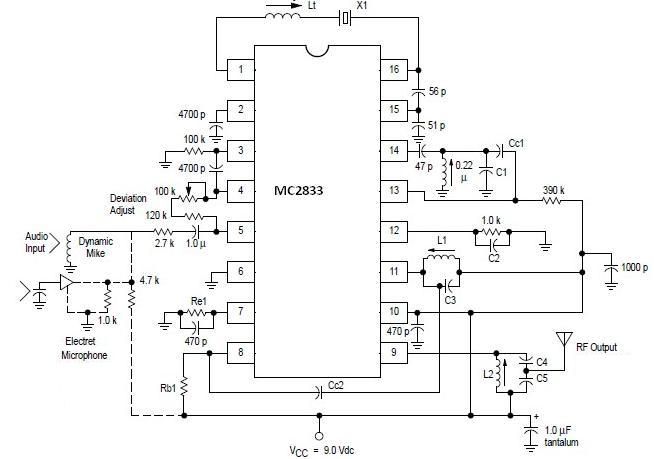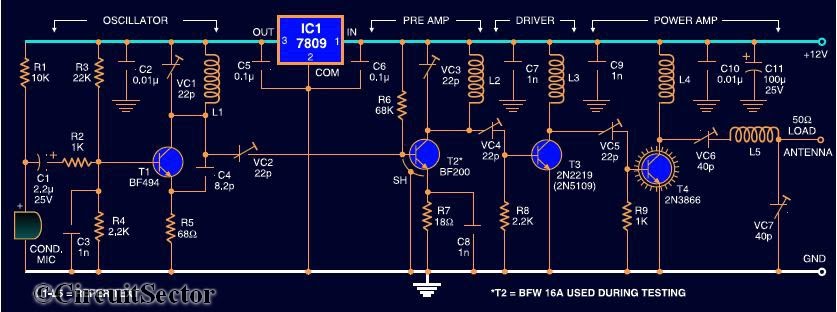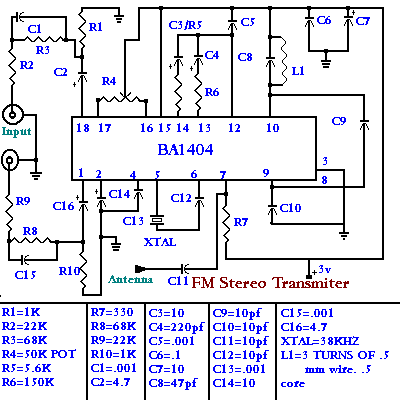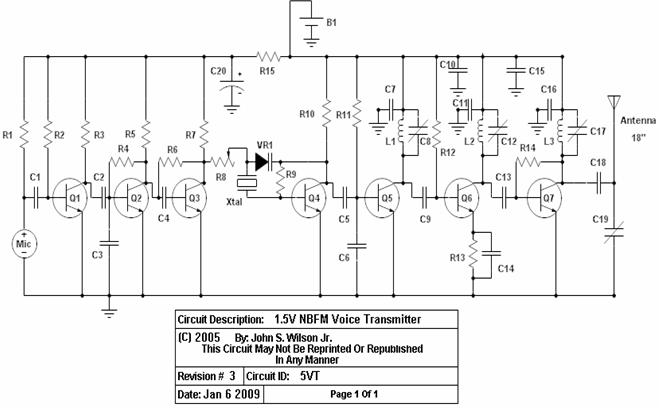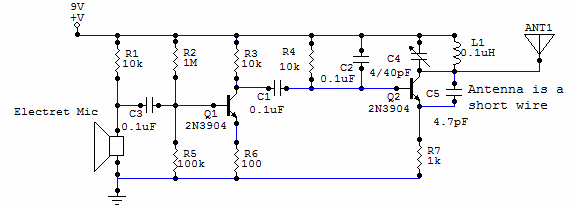
Novice CW Transmitter
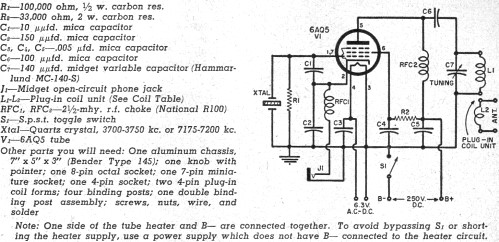
Although this CW transmitter circuit was published in 1955 in Popular Electronics, it remains legal for today's amateur radio operators. Portions of the 40-meter and 80-meter bands are still reserved exclusively for CW operation. As of 2011, the frequencies for the 40-meter band are 7.025 - 7.125 MHz, and for the 80-meter band, they are 3.525 - 3.600 MHz, designated for CW use by operators holding either Novice (no longer issued) or Technician licenses. It is important to note that these frequencies differ from those provided in the article, so caution is advised if one considers constructing this circuit for nostalgic purposes. The crystal value will need to be adjusted accordingly, as both bands are slightly lower than indicated, which may require minor tuning adjustments. For those without design experience, it is advisable to seek a newer circuit already adapted for the current bands. A novice ham radio operator should aim to become active quickly with a low-powered telegraph (CW) transmitter. Frequent operation of this rig will provide valuable on-air experience in handling Morse code and adhering to proper operating procedures. The most effective way to learn is through practical experience. A novice's first transmitter should be simple and affordable, with lower frequency bands being preferable. New operators typically encounter more local contacts and "rag chewers" on these bands than on the higher frequency long-distance bands. In the 80-meter band, novice CW operation is allowed between 3700 and 3750 kHz, while in the 40-meter band, the novice segment is from 7175 to 7200 kHz. Crystal control is mandatory. The transmitter described here is specifically designed for beginners. Although it is low-powered, it performs adequately when paired with a good antenna. Its compact design fits into an aluminum radio chassis box (Bender Type 145) measuring 7 inches long, 5 inches wide, and 3 inches high. To minimize costs and reduce hum from power equipment, no power supply is integrated into the transmitter. This design allows the user to connect any external unit that provides 250 volts DC at 50 to 65 mA and 6.3 volts AC or DC at 1 ampere. Most experimenters have a small power supply of this type available for general use, which can also be acquired inexpensively from surplus sources. The necessary AC and DC voltages can often be sourced from the receiver used alongside the transmitter. For portable applications, a 6-volt storage battery may be used in conjunction with 180 to 225 volts of "B" batteries or a vibrator-type 250-volt supply. The schematic diagram illustrates the transmitter's circuit, utilizing a 6AQ5 tube (V1) in a crystal oscillator configuration. This circuit is known for its effective keying. A shunt-fed plate circuit is employed, where the output (tank) circuit, comprising coil L1 and tuning capacitor C7, is isolated from the DC plate voltage of the tube via capacitor C6. This setup prevents DC voltage from reaching the coil, thereby protecting the operator from electric shock. However, it is still advisable to switch S1 to the "off" position before changing coils, as RF voltage can still pose a risk of burns. An 8-pin octal tube socket is installed on the left end of the chassis to accommodate the crystal. Pins 1 and 4 are designated for the crystal holder, while the remaining pins serve as tie points for resistor R1, capacitors C1 and C2, and leads. A 1 1/8" hole is required for the crystal socket installation. A 7-pin miniature tube socket for V1 is positioned in a 5/8" diameter hole near the chassis center. At the right end of the chassis, a 4-pin tube socket is mounted in a 1 1/8" hole to hold the plug-in components.
The CW transmitter circuit is designed to operate within the amateur radio bands, specifically tailored for novice operators. The circuit's simplicity ensures that it can be constructed with minimal components, making it accessible for beginners. The use of a crystal oscillator provides reliable frequency stability, crucial for effective CW communication. The circuit's design emphasizes safety by isolating high voltages from the operator, while still allowing for effective RF transmission. This transmitter can be a valuable tool for learning Morse code and gaining practical experience in amateur radio operations. The compact chassis design allows for easy integration into various setups, making it suitable for both stationary and portable use. Overall, this CW transmitter circuit remains a practical and educational option for amateur radio enthusiasts looking to engage in CW operation.Even though this CW transmitter circuit was published in 1955 in Popular Electronics, it is still legal for today`s Amateur radio operator. Portions of the 40-meter and 80-meter bands are still reserved exclusively for CW operation. As of 2011 in the 40-meter band 7. 025 - 7. 125 MHz, and for 80-meters 3. 525 - 3. 600 MHz are reserved for CW for Hams holding either Novice (no longer issued) or Technician licenses.
That is different than the frequencies given in the article, so beware if you are tempted to throw one together for old time`s sake. The value for XTAL will need to be changed accordingly. Both bands are a bit lower than shown here, so you might need to tweak the tuning elements a tad as well.
If you are not a designer, you would be better off just finding a newer circuit that is already configured for the new bands. The beginner in ham radio with a novice license should become active as quickly as possible with a low-powered telegraph (CW) transmitter.
Operating this rig as often as he can will give valuable on-the-air experience in handling the code and in correct operating procedure. The best way to learn is by doing. A novice`s first transmitter should be both simple and inexpensive. A good idea is to use the lower frequency bands. There, the new operator usually will find more "rag chewers" and local contacts than on the higher frequency long-distance bands.
In the 80-meter band, novice CW operation is permitted between 3700 and 3750 kc. In the 40-meter band, the novice`s territory is 7175 to 7200 kc. Crystal control must be used. The transmitter shown here was made especially for beginners. While it is low-powered, it will give a good account of itself when operated with a good antenna. It does not take up much room, since it is built on an aluminum radio chassis box (Bender Type 145) 7" long, 5" wide, and 3" high. To reduce expense and to keep hum-producing power equipment off the transmitter chassis, no power supply is built into the transmitter.
This allows the experimenter to use any external unit supplying 250 volts d. c. at 50 to 65 ma. and 6. 3 volts - a. c, or d. c. at 1 ampere. Most experimenters keep a small power supply of this type on hand for general use. Such units also can be bought cheaply in surplus. The necessary a. c. and d. c. voltages often can be drawn from the receiver used with the transmitter. For portable use, a 6-volt storage battery can be used in conjunction with 180 to 225 volts of "B" batteries or a vibrator-type 250-volt supply. The schematic diagram shows the circuit of the transmitter. A 6AQ5 tube (V1) is used in a crystal oscillator circuit. This particular circuit keys quite well. A shunt-fed plate circuit is employed. That is, the output (tank) circuit, consisting of coil L1 and tuning capacitor C7, is isolated from the d.
c. plate voltage of the tube by capacitor C6. This arrangement keeps d. c. voltage off the coil and protects the operator from electric shock. Nevertheless, switch S1 should be thrown to its "off" position before changing coils, since the r. f. voltage may burn the fingers quite painfully just the same. An 8-pin octal tube socket is mounted on the left end of the chassis to hold the crystal. Socket pins 1 and 4 receive the pins of the crystal holder, while other pins of this socket are used as tie points for resistor R1 capacitors C1, and C2, and leads. A 1 1/8" hole is needed for the crystal socket. A 7-pin miniature tube socket for V1, is mounted in a 5/8" -diameter hole near the center. At the right-hand end of the chassis, a 4-pin tube socket is mounted in a 1 1/8" hole to hold the plug-in
🔗 External reference
The CW transmitter circuit is designed to operate within the amateur radio bands, specifically tailored for novice operators. The circuit's simplicity ensures that it can be constructed with minimal components, making it accessible for beginners. The use of a crystal oscillator provides reliable frequency stability, crucial for effective CW communication. The circuit's design emphasizes safety by isolating high voltages from the operator, while still allowing for effective RF transmission. This transmitter can be a valuable tool for learning Morse code and gaining practical experience in amateur radio operations. The compact chassis design allows for easy integration into various setups, making it suitable for both stationary and portable use. Overall, this CW transmitter circuit remains a practical and educational option for amateur radio enthusiasts looking to engage in CW operation.Even though this CW transmitter circuit was published in 1955 in Popular Electronics, it is still legal for today`s Amateur radio operator. Portions of the 40-meter and 80-meter bands are still reserved exclusively for CW operation. As of 2011 in the 40-meter band 7. 025 - 7. 125 MHz, and for 80-meters 3. 525 - 3. 600 MHz are reserved for CW for Hams holding either Novice (no longer issued) or Technician licenses.
That is different than the frequencies given in the article, so beware if you are tempted to throw one together for old time`s sake. The value for XTAL will need to be changed accordingly. Both bands are a bit lower than shown here, so you might need to tweak the tuning elements a tad as well.
If you are not a designer, you would be better off just finding a newer circuit that is already configured for the new bands. The beginner in ham radio with a novice license should become active as quickly as possible with a low-powered telegraph (CW) transmitter.
Operating this rig as often as he can will give valuable on-the-air experience in handling the code and in correct operating procedure. The best way to learn is by doing. A novice`s first transmitter should be both simple and inexpensive. A good idea is to use the lower frequency bands. There, the new operator usually will find more "rag chewers" and local contacts than on the higher frequency long-distance bands.
In the 80-meter band, novice CW operation is permitted between 3700 and 3750 kc. In the 40-meter band, the novice`s territory is 7175 to 7200 kc. Crystal control must be used. The transmitter shown here was made especially for beginners. While it is low-powered, it will give a good account of itself when operated with a good antenna. It does not take up much room, since it is built on an aluminum radio chassis box (Bender Type 145) 7" long, 5" wide, and 3" high. To reduce expense and to keep hum-producing power equipment off the transmitter chassis, no power supply is built into the transmitter.
This allows the experimenter to use any external unit supplying 250 volts d. c. at 50 to 65 ma. and 6. 3 volts - a. c, or d. c. at 1 ampere. Most experimenters keep a small power supply of this type on hand for general use. Such units also can be bought cheaply in surplus. The necessary a. c. and d. c. voltages often can be drawn from the receiver used with the transmitter. For portable use, a 6-volt storage battery can be used in conjunction with 180 to 225 volts of "B" batteries or a vibrator-type 250-volt supply. The schematic diagram shows the circuit of the transmitter. A 6AQ5 tube (V1) is used in a crystal oscillator circuit. This particular circuit keys quite well. A shunt-fed plate circuit is employed. That is, the output (tank) circuit, consisting of coil L1 and tuning capacitor C7, is isolated from the d.
c. plate voltage of the tube by capacitor C6. This arrangement keeps d. c. voltage off the coil and protects the operator from electric shock. Nevertheless, switch S1 should be thrown to its "off" position before changing coils, since the r. f. voltage may burn the fingers quite painfully just the same. An 8-pin octal tube socket is mounted on the left end of the chassis to hold the crystal. Socket pins 1 and 4 receive the pins of the crystal holder, while other pins of this socket are used as tie points for resistor R1 capacitors C1, and C2, and leads. A 1 1/8" hole is needed for the crystal socket. A 7-pin miniature tube socket for V1, is mounted in a 5/8" -diameter hole near the center. At the right-hand end of the chassis, a 4-pin tube socket is mounted in a 1 1/8" hole to hold the plug-in
🔗 External reference
